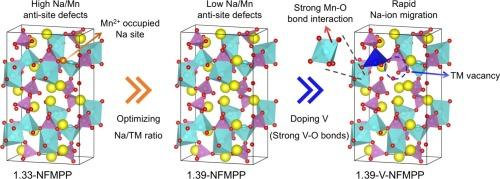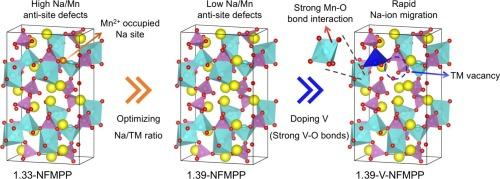高功率长寿命钠离子电池中Na4Fe1.5Mn1.5(PO4)2(P2O7)的反位缺陷和Jahn-Teller效应
IF 4.3
2区 工程技术
Q2 ENGINEERING, CHEMICAL
引用次数: 0
摘要
高安全、低成本的Na4Fe1.5Mn1.5(PO4)2(P2O7) (NFMPP)是一种极有前途的钠离子电池(sib)阴极材料,具有比典型NFPP更高的能量密度。然而,由于Na/Mn反位缺陷和J-T畸变,其性能受到阻碍,导致电压滞后和Na离子扩散动力学缓慢。在此,我们通过协同优化Na离子与过渡金属(Na/TM)的初始摩尔比和钒(V)掺杂,展示了一种高速率和长寿命的NFMPP阴极。Na/Mn反位缺陷从5.9% %降低到2.2 %,有效抑制了Mn2+/Mn3+氧化还原平台的电压滞后。同时,具有强V- o键的富电子V掺杂(541 kJ/mol)与Mn表现出较强的相互作用,显著降低了J-T畸变对na离子扩散的影响。因此,优化后的NFMPP阴极在0.1C下提供了115.1 mAh/g的初始充电容量,并实现了334 Wh/kg的高可逆能量密度,超过了许多报道的磷酸盐基阴极。它还表现出卓越的循环稳定性,在500次循环后保持94.1 %的容量,使其成为下一代sib的极具竞争力的候选者。本文章由计算机程序翻译,如有差异,请以英文原文为准。


Alleviating anti-site defects and Jahn-Teller effects in Na4Fe1.5Mn1.5(PO4)2(P2O7) for high-power and long-life Na-ion batteries
High-safety and low-cost Na4Fe1.5Mn1.5(PO4)2(P2O7) (NFMPP) is a highly promising cathode for Na-ion batteries (SIBs), offering a higher energy density than typical NFPP. However, its performance is hindered by Na/Mn anti-site defects and Jahn-Teller (J-T) distortion, resulting in voltage hysteresis and sluggish Na-ion diffusion kinetics. Herein, we demonstrate a high-rate and long-life NFMPP cathode by synergistically optimizing the initial molar ratio of Na-ion to transition metal (Na/TM) and vanadium (V) doping. The Na/Mn anti-site defects have been greatly alleviated from 5.9 % to 2.2 %, effectively suppressing the voltage hysteresis of Mn2+/Mn3+ redox plateau. Meantime, the electron-rich V doping with strong V-O bonds (541 kJ/mol) exhibits strong interaction with Mn, significantly reducing the effect of J-T distortion on Na-ion diffusion. As a consequence, the optimized NFMPP cathode delivers a superior initial charge capacity of 115.1 mAh/g at 0.1C and achieves a high reversible energy density of 334 Wh/kg, surpassing many reported phosphate-based cathodes. It also exhibits exceptional cycling stability, retaining 94.1 % of its capacity after 500 cycles, making it a highly competitive candidate for next-generation SIBs.
求助全文
通过发布文献求助,成功后即可免费获取论文全文。
去求助
来源期刊

Chemical Engineering Science
工程技术-工程:化工
CiteScore
7.50
自引率
8.50%
发文量
1025
审稿时长
50 days
期刊介绍:
Chemical engineering enables the transformation of natural resources and energy into useful products for society. It draws on and applies natural sciences, mathematics and economics, and has developed fundamental engineering science that underpins the discipline.
Chemical Engineering Science (CES) has been publishing papers on the fundamentals of chemical engineering since 1951. CES is the platform where the most significant advances in the discipline have ever since been published. Chemical Engineering Science has accompanied and sustained chemical engineering through its development into the vibrant and broad scientific discipline it is today.
 求助内容:
求助内容: 应助结果提醒方式:
应助结果提醒方式:


